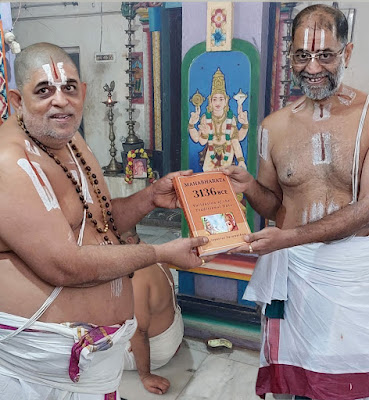Jayasree Saranathan
I am glad to announce the release of my book. “Mahabharata 3136 BCE: Validation of the Traditional Date” on the occasion of the completion of birth centenary of my father today. This book dedicated to my father is released by our Ācārya swami, Sri U. Ve. Ko. Ka. Appan Praṇatārtiharācāriār Swāmi at his Tirumāḷigai near Sri Varadarāja Perumāl temple in Kāncipuram. The first copy is received by our Ācārya Swami Sri U. Ve. Ko. Ka. Appan Dāśarathi Swami.
Try Adsterra Earnings, it’s 100% Authentic to make money more and more.




I am privileged to get the manuscript read and fore-worded by three luminaries from three fields related to the Mahābhārata – astrology, religious literature and civilizational studies. I am indebted to Sri Niranjan Babu, the Chief Editor of The Astrological eMagazine and the son of the illustrious Dr. B. V. Raman for reading the manuscript and giving his valuable feedback. My gratitude finds no bounds for the foreword given by ‘Pravachana Ratna Mani’, Sri Dushyanth Sridhar. I am at a loss for words to express my gratefulness to Smt Sandhya Jain for proof-reading the text and giving her valuable thoughts about the book.

This book authenticates the year of the Mahābhārata war as 3136 BCE, embedded in the Text of the Mahābhārata as the 36th year before Kṛṣṇa left on 3101 BCE when the current Time period of Kali Mahā Yuga began. It is important to validate this date to position the Mahābhārata in the Indic chronology to synchronize with the archaeological findings in Harappan settlements. The appearance of these settlements with advanced city planning and material culture could not have been sudden but a continuation of a pre-existing civilization. Mahābhārata offers the link to that pre-history.
This book of 18 chapters deals with the problems in dating, particularly with the use of astronomy simulators in the first Part where the issues around Kali Yuga date are settled textually and epigraphically. The second Part focuses on validating the date using the inputs on nimitta-s of terrestrial, atmospheric and celestial observations and syncing them with the traditional calendric references given in the text.
A surprise revelation of the systematic study of these inputs is the discovery of a cosmic impact, embedded in the GISP2 temperature graph of the Holocene – that makes the Mahābhārata a true historical document of mankind’s first-ever eye-witness record of the crash of a fragmented comet on the earth and the moon simultaneously. The impact caused early Amāvāsyā on the 13th tithi, that was perpetuated into memory as Bodhāyana Amāvāsyā and pushed the earth into a longer path causing a delay of Uttarāyaṇa, forcing Bhīṣma to wait on the arrow bed. The tithi-star alignment changed forever- the changed alignment continuing even now- and is remembered as Ratha Saptamī. With so many tricky issues concealed in the Mahābhārata requiring us to follow Lord Gaṇeśa-moment every now and then, this book seeks to solve the incomprehensible verses to establish the date as the 36th year before Kali Yuga began.
The decipherment continues to uncover the location of Kṛṣṇa’s Dwārakā and the causes for its loss. The focus then shifts to what happened to the remaining population of Dwārakā who fled the city after the deluge. The Epilogue gives the details of their settlements. The early Harappan regions being home to many Mahābhārata characters including the maternal ancestors of the Kuru-clan, the home of the son-in law of the Kaurava-s and animal motifs of the Harappan the same as those of the losers of the Mahābhārata war, the validation of the date of Mahābhārata gains significance by offering the hitherto unknown two phases of the Early Harappan, as pre-Mahābhārata and post-Mahābhārata, with the latter offering continuity to Mature Harappan with fresh settlements of the displaced people of the Dwārakā-flood, starting the Sarasvatī culture.
The Epilogue further traces the second migration of the Dwārakā-people from the Sarasvatī region around 1500 BCE to Bet Dwārakā and to South India. Yet another migration from the Sindhu region to South India had taken place around 2000 years ago. The Epilogue also offers inputs from the Rāmāyana of Vālmīki on the autochthonous origin of the Yamnaya people in India in the 7th millennium BCE.
The printed copy of this book running into 436 pages and priced at Rs. 475 (postal charges extra) can be obtained by sending an e-mail to jayasreebooks@gmail.com
The e-book is available at Amazon.com
https://www.amazon.in/dp/B09LS1WZ4X (India)
https://www.amazon.com/dp/B09LS1WZ4X (USA)
https://www.amazon.co.uk/dp/B09LS1WZ4X (UK)
https://www.amazon.de/dp/B09LS1WZ4X (Germany)
https://www.amazon.fr/dp/B09LS1WZ4X (France)
https://www.amazon.es/dp/B09LS1WZ4X (Spain)
https://www.amazon.com.au/dp/B09LS1WZ4X (Australia)
Readers can leave their comments, opinions and suggestions in the comment section of this blog.
More Story on Source:
*here*
Jayasree Saranathan
Published By

Latest entries
 allPost2025.01.24One Tip To Dramatically Improve Your Betting value: How to find profitable spots in niche betting markets
allPost2025.01.24One Tip To Dramatically Improve Your Betting value: How to find profitable spots in niche betting markets allPost2025.01.24New York esthetician accused of injecting fake botox into clients
allPost2025.01.24New York esthetician accused of injecting fake botox into clients allPost2025.01.24Elon Musk posts Nazi-related puns after backlash over inauguration gesture
allPost2025.01.24Elon Musk posts Nazi-related puns after backlash over inauguration gesture allPost2025.01.2411 Ways To Reinvent Your How to improve your betting portfolio with advanced statistics
allPost2025.01.2411 Ways To Reinvent Your How to improve your betting portfolio with advanced statistics



